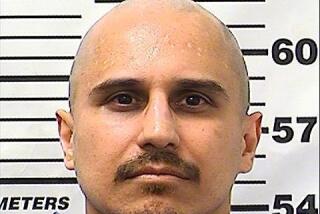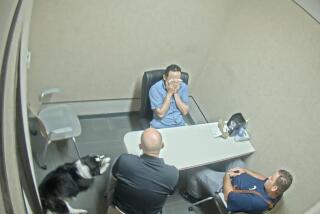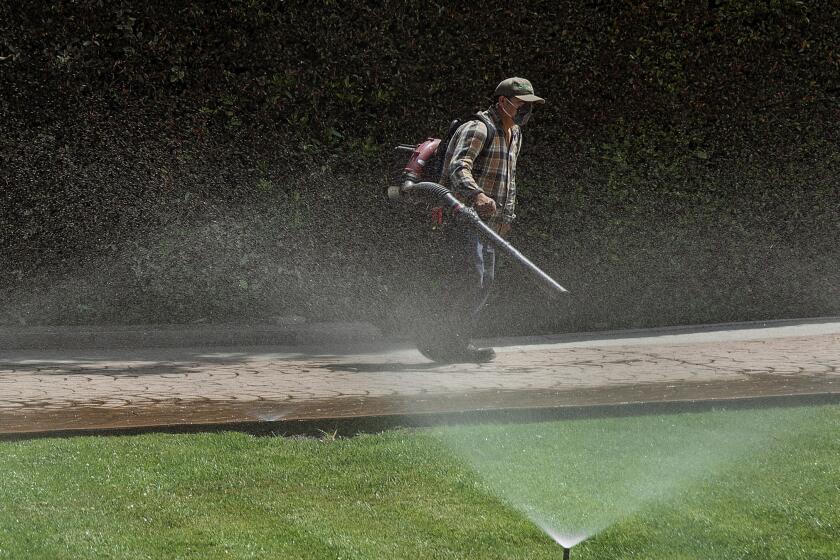Prosecutors Did Not Target Jurors for Removal, Ito Says : Simpson trial: Judge rejects claims by defense. He details his reasons for dismissing many panelists.
- Share via
Dealing another blow to O.J. Simpson’s defense team, Superior Court Judge Lance A. Ito on Wednesday rejected claims that prosecutors targeted certain jurors for removal.
Ito’s written order resoundingly rejected defense accusations of jury tampering, which prosecutors have long contested, and for the first time detailed his reasons for removing many of the panelists. In his six-page ruling, Ito cited issues ranging from jurors’ truthfulness to their behavior on the jury to their failure to disclose incidents of domestic abuse.
“This record does not support an inference that jurors are or have been targeted for removal by any governmental agency,” Ito wrote.
Ito’s ruling is the latest setback for Simpson’s attorneys, coming on the heels of rulings that curtailed their efforts to suggest that Faye Resnick was the target of the murders and that cut off their request to question prosecutors about a practice session involving Detective Mark Fuhrman.
Simpson has pleaded not guilty to the June 12, 1994, murders of Nicole Brown Simpson and Ronald Lyle Goldman.
Combined, Ito’s three recent rulings have significantly curbed the scope of Simpson’s defense. In addition, another aspect of the defense effort encountered rough going in front of the jury Wednesday, as a witness called to help lay the groundwork for the Simpson team’s conspiracy theory admitted to evidence tampering, lying and filing a lawsuit against an official police garage to protest his firing.
According to the judge, defense attorneys requested the ouster of five of the 10 jurors who have been dismissed from the case; prosecutors moved for the dismissal of four others. The 10th, a flight attendant who became distraught and begged to be released, was agreed to by both sides.
Moreover, Ito said, only one of the four jurors whose dismissals were favored by the prosecution was released based on information provided to the court by a government source. That juror, Jeannette Harris, was found to have concealed a history of domestic violence, Ito said, validating information that originally came to investigators from a Los Angeles police officer.
Although Harris and another dismissed juror, Willie Cravin, both have suggested that their race--African American--could have contributed to the prosecution’s unhappiness with them, Ito’s order spelled out reasons why he decided to oust both.
His description of the events leading up to Cravin’s dismissal was particularly detailed, sketching out six incidents in which Cravin allegedly intimidated fellow panelists--including two women, whose small stature Ito contrasted with Cravin’s 200-pound frame. Cravin denied any conflicts, but Ito said he “found this denial to lack credibility and that [Cravin’s] conduct was disruptive of the truth-finding process.”
“No governmental action is apparent,” Ito also wrote, clearing the prosecution of responsibility for Cravin’s dismissal.
At the same time, Ito rejected assertions by Simpson attorney Johnnie L. Cochran Jr., who leveled the accusations of jury tampering, with a swipe at Cochran and prosecutor Christopher A. Darden.
“The boasting and baiting conduct which has been engaged in between Deputy Dist. Atty. Christopher Darden and defense counsel Johnnie L. Cochran Jr. both in and out of court,” Ito wrote, “is both obnoxious and childish and not a reasonable, credible or sufficient basis for the court to conduct a hearing into allegations of juror targeting.”
Since 24 jurors and alternates were impaneled in mid-January, attrition has depleted the ranks and has periodically raised the possibility of a mistrial. The departures have halted in recent weeks, but only two alternate jurors remain for the balance of the case, which could last into September.
Another Witness Struggles
Ito’s order was not shared with the jury. But inside court, the panelists watched intently as Simpson’s lawyers struggled with yet another vexing witness, this time as they launched the phase of their case devoted to raising the specter of a police conspiracy to plant evidence against their client.
Tow truck driver John J. Meraz told the jury that he had not seen blood inside Simpson’s Bronco and testified about lax protection given to the vehicle, two points that the defense needed to establish to raise questions about the integrity of the police investigation.
Under questioning by Cochran, the witness repeatedly stressed that he had not seen blood in Simpson’s Ford Bronco when he looked inside the vehicle after the murders.
“I didn’t see any blood,” he testified, adding that he was looking inside the Bronco because of news reports suggesting that blood was inside the vehicle. That is potentially damaging testimony to the prosecution’s case because it could bolster a defense contention that blood later found inside the Bronco--including stains with genetic markers suggesting that they could have come from Simpson and two victims--was planted in the car.
But other witnesses, including a police officer called by the defense, have said they did see blood in the car, and Deputy Dist. Atty. Marcia Clark confronted Meraz with a buzz-saw cross-examination that focused largely on the witness’s admission that he had taken some receipts from Simpson’s car and lied about it when confronted by his boss.
Faced with defense witnesses, Clark has moved from solicitous questioning of family members and some others to bristling, aggressive attacks on others. On Wednesday, she set the tone for her cross-examination of Meraz with her first question.
After a perfunctory “good morning,” Clark asked in a steely voice: “When Mr. Jones first confronted you with having taken those receipts from the Bronco, you lied, didn’t you?”
“That’s correct,” Meraz responded.
In fact, Meraz had acknowledged taking the receipts under questioning by Cochran as well, but where the defense attorney had touched delicately on the topic, Clark bore down.
As she continued her questioning, Clark attacked everything from Meraz’s sincerity to his eyesight, confronting him with more than a dozen challenges to his testimony.
When Meraz testified that there was no powder on the car, such as that used to search for fingerprints, Clark showed him a photograph of the car sprinkled with the black dust. When Meraz denied wanting to make money off a lawsuit that he brought against his former employer for firing him, Clark reminded the jury that his lawyers were in the courtroom and eventually elicited his acknowledgment that “if [money] comes my way, I’ll take it.”
And when Meraz was asked about whether he had signed a statement about taking receipts from Simpson’s car, his evasive answer sparked a testy exchange with the prosecutor.
“You don’t recall ever signing a statement concerning your theft of the receipts from the Bronco?” Clark asked after Meraz had said he could not remember any such statement.
“I don’t recall that,” he said, “unless you got something.”
“Oh,” Clark said, her voice scornful, “you mean you will change your testimony if I show you something?”
“That is not what I’m saying,” Meraz said. But later, when confronted with a brief statement in his handwriting and signed with his signature, he said he did remember writing the note.
‘Critical to Our Defense’
Meraz was not the first defense witness to offer a mixed bag for the Simpson team.
A doctor had testified that Simpson suffered from arthritis, but had told the jury that he could have committed the murders under certain conditions. A Brentwood resident said he had not heard a dog wailing until later than the prosecution contends the murders were committed, but also had testified about seeing a Bronco-like car speeding from the scene.
And a senior LAPD officer helped contradict the testimony of Detective Philip L. Vannatter about why Simpson was handcuffed upon returning home on the day after the murders. But the same officer told the panel that he also believed Simpson should have been handcuffed and added that the defendant seemed to be treated more deferentially than most murder suspects.
In some ways, Meraz presented even more problems than those other witnesses, as he was the only one to acknowledge having lied. At the same time, however, his testimony about taking the receipts from Simpson’s car and showing them to co-workers bolstered the defense’s contention that the evidence in the Simpson case was handled carelessly from the outset.
Outside court, one of Simpson’s lawyers acknowledged that Meraz’s testimony had risks for the defense, but said it was worth the gamble.
“We knew, of course, that some of that was going to come out,” said Carl Douglas, one of Simpson’s lawyers. “But whatever else he may have said, he clearly established the lack of security around the Bronco, and that is critical to our defense. They never touched him on that issue.”
The defense also got helpful testimony just as the court day drew to a close Wednesday, when an LAPD photographer took the stand to describe a videotape he shot of the interior of Simpson’s house while his colleagues were serving a search warrant. Jurors got to see the tape, shot to protect the city from claims that police stole or damaged anything inside the house, and ended the day just as Cochran reached the crucial point.
With the photographer, Willie Ford, narrating, the camera panned Simpson’s bedroom, including the area near the foot of the defendant’s bed. It was there that LAPD criminalist Dennis Fung said he collected a pair of bloodstained socks--which later were tested and found to contain blood with genetic markers identical to those in Nicole Simpson’s blood.
But Ford said he had not seen the socks there at 4:13 p.m. on June 13, when he shot the video. Although he was hazy on the exact time, Fung told the jury that he had not collected those socks until after 4:30 p.m., and the contradiction between their accounts may give the defense room to argue that someone is not telling the truth.
The socks have long formed a key arguing point for both sides. Defense attorneys revealed outside the jury’s presence Wednesday that they have enlisted the services of a professor, Herbert MacDonnell, who they described as the world’s foremost authority on blood-splatter evidence. According to Simpson attorney Peter Neufeld, the expert is prepared to testify that the stain in question appears to have been smeared on the sock and not splattered.
Prosecutors object to that testimony, partly because they take issue with an experiment performed by the expert and partly because they argue that the socks have been so manipulated during testing that the blood splatters are impossible to recreate.
Ito heard arguments from both sides on the issue, but did not immediately rule.
More Videotapes
The videotape of Simpson’s bedroom closed out the court day on a strong note for the defense, but earlier prosecutor Darden had used an exercise tape to call the jury’s attention to a provocative but ambiguous comment made by Simpson three weeks before the murders.
Jurors had seen the tape Tuesday, but had not appeared to take notice of a remark by Simpson that the prosecution considers significant.
While shadowboxing on the tape, Simpson states: “You just gotta get your space in if you’re working out with the wife, if you know what I mean. You could always blame it on working out.”
Prosecutors say the comment shows Simpson’s callousness about domestic abuse; defense lawyers contend that it was a joke and not relevant to the case. They initially fought the prosecution’s use of it at all, and on Wednesday, Ito prevented Darden from playing it again for the jury, so the prosecutor read it instead.
Asked about the comment, exercise instructor Richard Walsh, who had spent much of his testimony mugging and smiling, suddenly turned serious and said the remark was ad-libbed by Simpson, not scripted. Walsh also testified that the former football star--convicted of spousal battery in 1989 after pleading no contest--made the comment twice.
Under questioning by Cochran, Walsh had said that he was surprised by how badly Simpson’s injuries seemed to limit his mobility. In fact, Walsh said, he initially had thought Simpson a bad choice for the video project.
In addition, the witness described bumping into Simpson at one point during the filming and said that Simpson yelped in pain.
But Darden turned the tables on that line of questioning. After first belittling Walsh’s accessibility to the media and his frequent appearances on tabloid television shows--the host of one, Geraldo Rivera, was in the audience and acknowledged Darden’s scornful comment about him with a jaunty salute--the prosecutor posed a series of questions about Simpson’s endurance during the taping.
The session went on for almost 15 hours, Walsh said, and though Simpson appeared stiff and uncomfortable at various points, the instructor acknowledged that his video star stuck it out. At one point, Walsh added, Simpson told him that it was like fighting off the pain during a football game.
The court day ended Wednesday on a somber and emotional note, as Ito turned to the jurors and told them about a tragedy that had befallen one of the sheriff’s deputies assigned to the courthouse. The normally articulate Ito struggled to compose his thoughts on the deputy, Antranik Geuvjehizian, who was shot and killed as he tried to investigate a break-in at his neighbor’s house.
“We affectionately knew him as Deputy G-12,” Ito said, his voice choking with emotion. “Department 103 will stand in recess this afternoon in his honor.”
More to Read
Sign up for Essential California
The most important California stories and recommendations in your inbox every morning.
You may occasionally receive promotional content from the Los Angeles Times.














